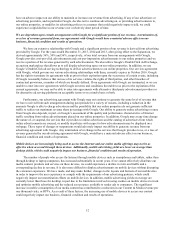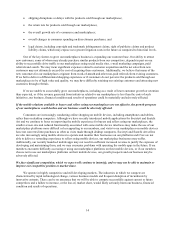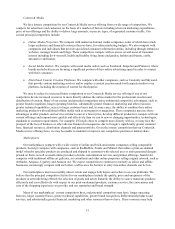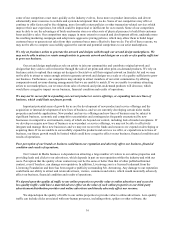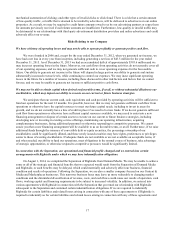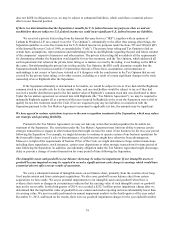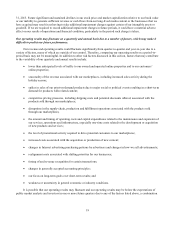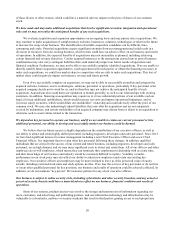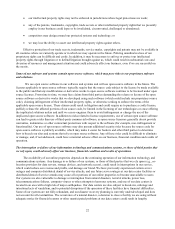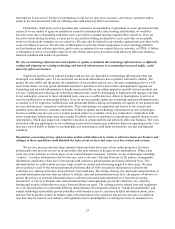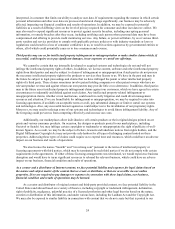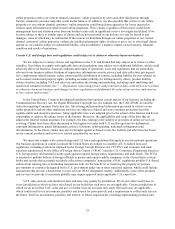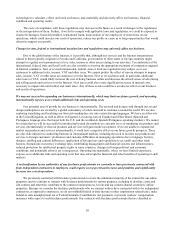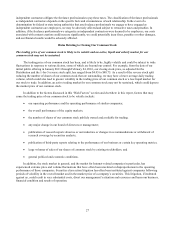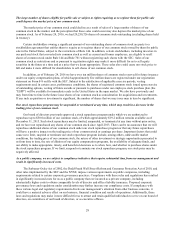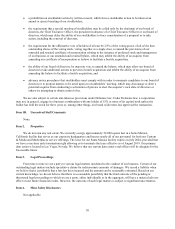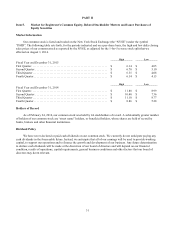Enom 2015 Annual Report Download - page 24
Download and view the complete annual report
Please find page 24 of the 2015 Enom annual report below. You can navigate through the pages in the report by either clicking on the pages listed below, or by using the keyword search tool below to find specific information within the annual report.22
x our intellectual property rights may not be enforced in jurisdictions where legal protections are weak;
x any of the patents, trademarks, copyrights, trade secrets or other intellectual property rights that we presently
employ in our business could lapse or be invalidated, circumvented, challenged or abandoned;
x competitors may design around our protected systems and technology; or
x we may lose the ability to assert our intellectual property rights against others.
Effective protection of our trade secrets, trademarks, service marks, copyrights and patents may not be available in
all countries where we currently operate or in which we may operate in the future. Policing unauthorized use of our
proprietary rights can be difficult and costly. In addition, it may be necessary to enforce or protect our intellectual
property rights through litigation or to defend litigation brought against us, which could result in substantial costs and
diversion of resources and management attention and could adversely affect our business, even if we are successful on
the merits.
Some of our software and systems contain open source software, which may pose risks to our proprietary software
and solutions.
We use open source software in our software and systems and will use open source software in the future. The
licenses applicable to open source software typically require that the source code subject to the license be made available
to the public and that any modifications or derivative works to open source software continue to be licensed under open
source licenses. From time to time, we may face claims from third parties demanding the release or license of the open
source software or derivative works that we developed using such software (which could include our proprietary source
code), claiming infringement of their intellectual property rights, or otherwise seeking to enforce the terms of the
applicable open source license. These claims could result in litigation and could require us to purchase a costly license,
publicly release the affected portions of our source code, be limited in the licensing of our technologies or cease offering
the implicated solutions unless and until we can re-engineer them to avoid infringement or change the use of the
implicated open source software. In addition to risks related to license requirements, use of certain open source software
can lead to greater risks than use of third-party commercial software, as open source licensors generally do not provide
warranties, indemnities or other contractual protections with respect to the software (for example, non-infringement or
functionality). Our use of open source software may also present additional security risks because the source code for
open source software is publicly available, which may make it easier for hackers and other third parties to determine
how to breach our sites and systems that rely on open source software. Any of these risks could be difficult to eliminate
or manage, and, if not addressed, could have a material adverse effect on our business, financial condition and results of
operation.
The interruption or failure of our information technology and communications systems, or those of third parties that
we rely upon, could adversely affect our business, financial condition and results of operations.
The availability of our online properties depends on the continuing operation of our information technology and
communications systems. Any damage to or failure of our systems, or those of third parties that we rely upon (e.g., co-
location providers for data servers, storage devices, and network access), could result in interruptions in our service,
which could reduce our revenue and profits, and damage our brand. We have previously experienced certain server
outages and computer distributed denial of service attacks, and any future server outages at our data center facilities or
distributed denial of service attacks may cause all or portions of our online properties to become unavailable to users.
Our systems are also vulnerable to damage or interruption from natural disasters, terrorist attacks, power loss,
telecommunications failures, computer viruses or other attempts to harm our systems, and one of our data centers is
located in an area with a high risk of major earthquakes. Our data centers are also subject to break-ins, sabotage and
intentional acts of vandalism, and to potential disruptions if the operators of these facilities have financial difficulties.
Some of our systems are not fully redundant, and our disaster recovery planning is currently underdeveloped and does
not account for all eventualities. The occurrence of a natural disaster, a decision to close a facility we are using without
adequate notice for financial reasons or other unanticipated problems at our data centers could result in lengthy


